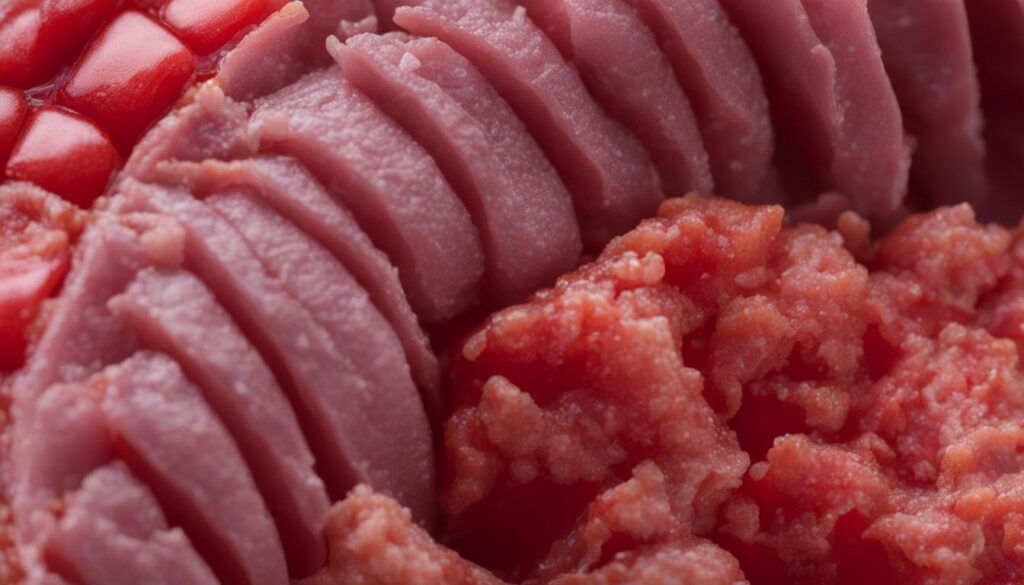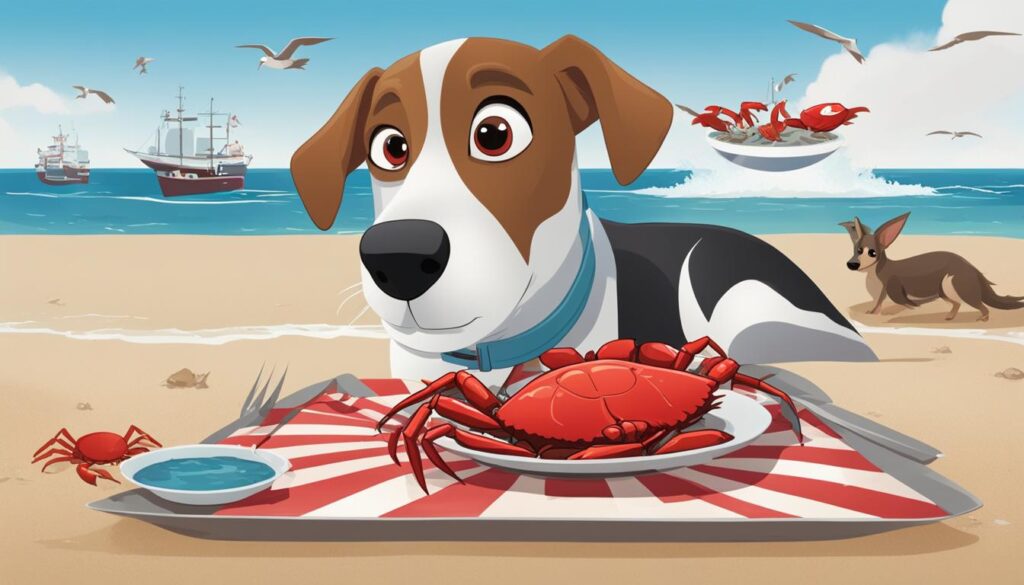While crab meat can be a delicious and nutritious treat for dogs, it’s important for pet owners to understand the potential risks and considerations involved in feeding crab meat to their furry friends. In this comprehensive guide, I will explore whether crab meat is safe for dogs to eat, the health benefits it can provide, as well as potential risks such as digestive issues and allergies. I will also discuss the best cooking methods and alternative protein sources for dogs.
Key Takeaways:
- Crab meat is generally safe for dogs, but there are important risks and considerations to be aware of.
- Raw crab meat should never be fed to dogs due to the risk of parasites and choking hazards.
- Crab meat is rich in lean protein, vitamins, minerals, and omega-3 fatty acids, benefiting a dog’s overall health.
- Dogs may experience digestive issues or allergic reactions to crab meat, and immediate veterinary attention may be necessary.
- When feeding crab meat to dogs, it should be thoroughly cooked and all shells should be removed to prevent any harm.
- Alternatives to crab meat, such as chicken, turkey, and lean beef, can provide similar nutritional benefits for dogs.
Is Crab Meat Safe for Dogs to Eat?

In general, crab meat is safe for dogs to eat. It is not toxic and can provide numerous health benefits. However, there are important risks and considerations to be aware of when feeding crab meat to your furry friend.
Risks and Considerations:
- Dogs should never consume raw crab meat as it can contain parasites and pose a choking hazard.
- The high sodium, iodine, and cholesterol content in crab meat can be harmful if consumed in excess.
Pet owners must carefully evaluate the risks and benefits before including crab meat in their dog’s diet. It’s always a good idea to consult with a veterinarian to determine if crab meat is suitable for your dog based on their individual health needs.
When feeding crab meat to your dog, it’s important to take precautions to ensure their safety and well-being:
- Cook the crab meat thoroughly to eliminate any potential parasites or bacteria.
- Remove all shells before feeding to prevent choking hazards.
Benefits of Crab Meat for Dogs

Crab meat offers several health benefits for dogs, making it a valuable addition to their diet. Here are some of the advantages:
- Rich in lean protein: Crab meat contains high-quality lean protein, which is essential for the growth and maintenance of canine muscles.
- Vitamins and minerals: This seafood is packed with valuable nutrients, including zinc, which supports a healthy immune system, and vitamin B12, which contributes to cognitive function.
- Omega-3 fatty acids: Crab meat is a good source of omega-3 fatty acids, which promote heart health and help maintain a shiny coat and healthy skin in dogs.
Protein for Strong Muscles
Protein is a crucial component of a dog’s diet, as it plays a vital role in building and repairing tissues. Crab meat provides dogs with a rich source of lean protein, which supports the development and maintenance of strong muscles. Including crab meat in a dog’s diet can help ensure they receive the essential amino acids necessary for their overall well-being.
Nutrients for a Healthy Immune System and Cognitive Function
Crab meat is not only rich in protein but also contains important vitamins and minerals. Zinc, found in crab meat, is essential for maintaining a healthy immune system in dogs, improving their ability to fight off infections and diseases. Additionally, crab meat is a natural source of vitamin B12, which plays a crucial role in supporting cognitive function and maintaining a dog’s mental alertness.
Promoting Heart Health and Skin Health
The omega-3 fatty acids found in crab meat offer numerous benefits for dogs. These fatty acids have anti-inflammatory properties, which can help reduce the risk of heart disease and promote a healthy cardiovascular system. Additionally, omega-3 fatty acids contribute to the development and maintenance of healthy skin, reducing itchiness and promoting a shiny coat in dogs.
To further illustrate the nutritional benefits of crab meat for dogs, here is a table highlighting the key nutrients found in 100 grams of crab meat:
| Nutrient | Amount |
|---|---|
| Protein | 19.5 grams |
| Fat | 1.08 grams |
| Zinc | 1.24 milligrams |
| Vitamin B12 | 11.5 micrograms |
| Omega-3 Fatty Acids | 180 milligrams |
Note: Nutrient content may vary slightly depending on the specific type and preparation of the crab meat.
As with any food, moderation is key when feeding crab meat to dogs. It is important to incorporate crab meat into a balanced diet and consider the dog’s overall nutritional needs. Additionally, it is recommended to consult with a veterinarian before introducing any new food to ensure it is appropriate for the dog’s specific dietary requirements.
Risks and Considerations of Feeding Crab Meat to Dogs

Despite its potential benefits, feeding crab meat to dogs comes with several risks and considerations that pet owners should be aware of. While dogs can enjoy this seafood delicacy, it is important to understand the potential hazards and take appropriate precautions to keep our furry friends safe.
One major risk is the possibility of dogs ingesting sharp crab shells, which can cause internal injuries. Dogs may swallow the shells accidentally or while attempting to crunch on them. To prevent this, it is crucial to remove all shells before serving crab meat to your dog.
Another concern is the potential for parasites in raw crab meat. Raw seafood, including crab meat, can harbor harmful parasites that are not safe for dogs to consume. These parasites can lead to digestive issues such as vomiting, diarrhea, and discomfort. To ensure the safety of your dog, always cook crab meat thoroughly before feeding.
Furthermore, some dogs may have allergies or hypersensitivity to crab meat. Just like humans, dogs can develop allergies to certain foods, including seafood. Symptoms can range from mild digestive issues to severe allergic reactions that require immediate veterinary attention. If you notice any signs of allergies such as itching, swelling, or breathing difficulties after feeding your dog crab meat, consult your veterinarian for guidance.
“Feeding crab meat to dogs comes with several risks, including the potential for sharp shell ingestion, parasites in raw meat, and allergic reactions.”
It is essential for pet owners to carefully monitor their dogs for any digestive issues or signs of allergies when introducing crab meat into their diet. If any problems arise, discontinue feeding crab meat and consult your veterinarian. They will be able to provide guidance on alternative protein sources and ensure your dog’s health and well-being.
Summary of Risks and Considerations:
| Risks and Considerations | Description |
|---|---|
| Sharp shell ingestion | Dogs may suffer internal injuries if they swallow crab shells. |
| Parasites in raw crab meat | Raw crab meat can harbor parasites that are harmful to dogs. Thorough cooking is necessary to eliminate this risk. |
| Allergic reactions | Some dogs may be allergic or hypersensitive to crab meat, leading to mild to severe allergic reactions. Monitor your dog for any signs of allergies. |
Cooking Methods for Dogs and Crab Meat

When it comes to preparing crab meat for dogs, proper cooking methods are essential to ensure their safety and enjoyment. Cooking the crab meat thoroughly is crucial in eliminating any potential parasites or bacteria that may be present. Follow these guidelines to prepare a delicious and safe meal for your furry friends:
-
Boiling: Boiling is one of the safest ways to cook crab meat for dogs. Place the crab meat in a pot of boiling water and cook it until it reaches an internal temperature of 145°F (63°C). Avoid adding any butter or seasonings to the water as they can be harmful to dogs.
-
Steaming: Steaming is another excellent cooking method for crab meat. Place the crab meat in a steamer basket over boiling water and cook it until it becomes opaque and firm. Steaming helps retain the natural flavors of the crab meat without the need for any additional fats or seasonings.
Regardless of the cooking method used, it is important to remove all shells from the crab meat before serving it to dogs. Crab shells can pose a choking hazard and should never be fed to dogs.
By following these cooking methods, you can ensure that your canine companions enjoy a safe and delicious meal with crab meat. Remember to always prioritize your dog’s well-being and consult with a veterinarian if you have any concerns or questions about their diet.
Alternatives to Crab Meat for Dogs

If pet owners are concerned about the potential risks or their dogs have allergies to crab meat, there are plenty of alternative protein sources that can provide similar nutritional benefits. Chicken, turkey, and lean beef are excellent options that can be incorporated into a dog’s diet. It is important to note that some dogs may also have allergies or sensitivities to these alternatives, so introducing them gradually and monitoring for any adverse reactions is necessary.
Here are a few alternative protein sources that can be considered:
- Chicken: Chicken is a lean protein source that is readily available and easily digestible for dogs. It is rich in essential amino acids and can help support muscle growth and development.
- Turkey: Turkey is another lean protein option that provides dogs with essential nutrients. It is low in fat and can be a suitable alternative to crab meat for dogs with sensitive stomachs.
- Lean Beef: Lean beef is a protein-rich option that can provide dogs with essential amino acids, iron, and B vitamins. It should be cooked thoroughly and served without any seasoning or additives.
When introducing these alternatives to a dog’s diet, it is important to ensure they are cooked thoroughly and served in appropriate portions. It is also recommended to consult with a veterinarian to determine the best protein sources and feeding guidelines based on a dog’s specific needs and dietary restrictions.
| Protein Source | Nutritional Benefits | Potential Allergies |
|---|---|---|
| Chicken | Rich in essential amino acids, supports muscle growth and development | Some dogs may have allergies or sensitivities to chicken |
| Turkey | Low in fat, easily digestible, suitable for dogs with sensitive stomachs | Some dogs may have allergies or sensitivities to turkey |
| Lean Beef | Provides essential amino acids, iron, and B vitamins | Some dogs may have allergies or sensitivities to beef |
Can Dogs Eat Imitation Crab?
While some pet owners may consider imitation crab as a safer alternative to real crab meat, it is important to understand the risks and considerations involved. Imitation crab is a processed food that often contains additives and artificial ingredients that may not be beneficial for dogs. Although it may resemble real crab meat, it lacks the nutritional value and natural benefits that fresh seafood provides.
Feeding dogs imitation crab should be done sparingly, if at all, due to the potential negative effects of processed ingredients. The additives and preservatives present in imitation crab can be harmful to dogs and may cause digestive issues or allergic reactions. It is always best to prioritize natural, unprocessed protein sources in a dog’s diet to ensure their overall health and well-being.
Alternatives to Crab Meat for Dogs
If you are looking for alternative protein sources for your dog, there are several healthy options to consider:
- Chicken: Cooked chicken is a lean and easily digestible protein source for dogs. It is rich in essential nutrients, such as protein, vitamins, and minerals.
- Turkey: Similar to chicken, turkey is a nutritious alternative that provides dogs with essential amino acids and other beneficial nutrients. Just make sure to remove the skin and bones before feeding.
- Lean Beef: Lean cuts of beef, such as sirloin or round, can be a good source of protein for dogs. It is important to remove excess fat and cook the meat thoroughly to ensure digestibility.
By incorporating these alternative protein sources into your dog’s diet, you can provide them with a well-rounded and nutritious meal while avoiding the potential risks associated with imitation crab.
Comparison of Protein Sources for Dogs
| Protein Source | Nutritional Benefits | Risks and Considerations |
|---|---|---|
| Crab Meat | – Lean protein – Vitamins and minerals – Omega-3 fatty acids |
– Shell hazards – Potential parasites – Digestive issues – Allergic reactions |
| Imitation Crab | – Processed ingredients – Additives and preservatives |
– Digestive issues – Allergic reactions |
| Chicken | – Lean protein – Essential nutrients – Easily digestible |
– Bones and skin hazards if not removed |
| Turkey | – Nutritious protein source – Essential amino acids – Rich in vitamins and minerals |
– Bones and skin hazards if not removed |
| Lean Beef | – Protein-rich – Essential nutrients |
– Excess fat hazards if not removed – Cook thoroughly |
Feeding Guidelines for Dogs and Crab Meat

When introducing crab meat to your dog’s diet, it is crucial to proceed with caution and follow feeding guidelines to ensure their safety and well-being. Here are some important tips to consider:
- Start with small amounts: Begin by offering your dog a tiny portion of crab meat to gauge their reaction. This will enable you to monitor for any adverse effects and ensure their tolerance to this new food.
- Observe digestive system: After your dog consumes crab meat, pay close attention to their digestive system. Look out for any signs of discomfort such as vomiting, diarrhea, or excessive gas. If such symptoms occur, it may indicate that crab meat doesn’t agree with your dog’s digestive system.
- Monitor overall well-being: Apart from digestive issues, observe your dog’s overall well-being after eating crab meat. Keep an eye out for any changes in behavior, appetite, energy levels, or skin condition. If you notice any negative effects, it’s advisable to discontinue feeding crab meat.
- Consult a veterinarian: If your dog experiences any adverse reactions or if you have concerns about feeding crab meat, seek professional advice from a veterinarian. They can provide specific guidance based on your dog’s individual health and dietary needs.
- Moderate feeding: As with any new food, moderation is key. While crab meat can offer nutritional benefits, it should be incorporated into your dog’s diet in moderation. Balancing their overall food intake and ensuring a diverse range of nutrients is essential for their well-being.
Feeding Guidelines for Dogs and Crab Meat
| Feeding Guidelines | Advice |
|---|---|
| Start with small amounts | Offer a small portion of crab meat to assess tolerance. |
| Observe digestive system | Monitor for any signs of digestive discomfort. |
| Monitor overall well-being | Watch for changes in behavior, appetite, energy levels, or skin condition. |
| Consult a veterinarian | Seek professional advice if concerns or adverse reactions arise. |
| Moderate feeding | Incorporate crab meat into the diet in moderation and balance overall food intake. |
By following these feeding guidelines, you can ensure that your dog’s experience with crab meat is positive and safe. Remember, each dog is unique, and it’s important to prioritize their individual needs and well-being when introducing any new food into their diet.
Can Dogs Have Seafood Allergies?
While it is rare, some dogs may develop allergies or hypersensitivity to seafood, including crab meat. If you notice any of the following symptoms in your dog after consuming crab meat, it is essential to seek veterinary advice immediately:
- Gastrointestinal upset
- Vomiting
- Diarrhea
- Itchy skin
If you suspect that your dog has seafood allergies, consulting with a veterinarian is crucial. They may recommend allergy testing to confirm the diagnosis and determine the best course of action for your dog’s health and well-being.
Expert Quote:
“While most dogs can tolerate crab meat without any issues, it is important to be aware that some dogs may have allergic reactions or hypersensitivity to seafood. If you suspect such allergies in your dog, it is best to consult with a veterinarian for proper diagnosis and guidance.” – Dr. Sarah Johnson, Veterinary Allergist
Wrapping Up
In conclusion, the safety of feeding crab meat to dogs should be a top priority for pet owners. While crab meat can provide health benefits such as lean protein, essential vitamins, and omega-3 fatty acids, there are risks and considerations to be aware of. It is crucial to cook crab meat thoroughly and remove all shells to prevent choking hazards and potential internal injuries. Pet owners should also closely monitor their dog’s digestive system and watch for any signs of allergies or sensitivities to crab meat.
If any problems arise, such as digestive issues or allergic reactions, it is recommended to consult a veterinarian. They can provide guidance on alternative protein sources, such as chicken, turkey, or lean beef, which can offer similar health benefits without the associated risks. It is important to remember that each dog may have unique dietary needs and sensitivities, so a veterinarian’s advice should always be sought before introducing any new food into a dog’s diet.
Ultimately, the safety and well-being of our furry friends are of utmost importance. By following proper cooking methods, monitoring for any adverse reactions, and seeking professional guidance when needed, pet owners can make informed decisions about incorporating crab meat or alternative protein sources into their dog’s diet. With care and consideration, dogs can enjoy a varied and nutritious diet that promotes their overall health and happiness.
FAQ
Is crab meat safe for dogs to eat?
Yes, in general, crab meat is safe for dogs to eat. However, there are important risks and considerations to be aware of before including crab meat in their diet.
What are the health benefits of crab meat for dogs?
Crab meat is rich in lean protein, valuable vitamins and minerals, and omega-3 fatty acids. It can support muscle growth, immune system health, cognitive function, heart health, and skin health in dogs.
What are the risks and considerations of feeding crab meat to dogs?
The risks and considerations include potential choking hazards from sharp crab shells, the presence of parasites in raw crab meat, digestive issues, and allergic reactions in some dogs.
What are the recommended cooking methods for dogs and crab meat?
The safest cooking methods for dogs and crab meat include boiling or steaming without adding butter or seasonings. It is crucial to remove all shells before feeding the cooked crab meat to dogs to prevent choking hazards.
What are the alternatives to crab meat for dogs?
If dogs cannot have crab meat or have allergies to it, alternative protein sources like chicken, turkey, and lean beef are excellent options.
Can dogs eat imitation crab?
While some pet owners may consider imitation crab as a safer alternative to real crab meat, it is still a processed food that contains additives and artificial ingredients. It is generally recommended to focus on providing natural, unprocessed protein sources for dogs.
What are the feeding guidelines for dogs and crab meat?
When introducing crab meat to a dog’s diet, it is essential to start with small amounts and observe their reaction. If any adverse reactions occur, it is recommended to discontinue feeding crab meat and consult a veterinarian. Moderation is key to maintaining a balanced diet.
Can dogs have seafood allergies?
Yes, some dogs may develop allergies or hypersensitivity to seafood, including crab meat. If pet owners suspect seafood allergies, it is crucial to seek veterinary advice immediately for proper diagnosis and guidance.






